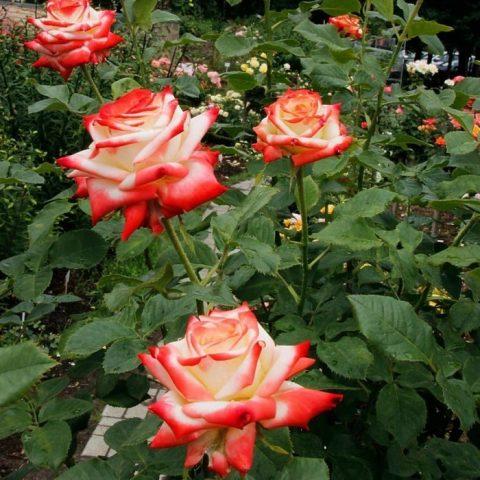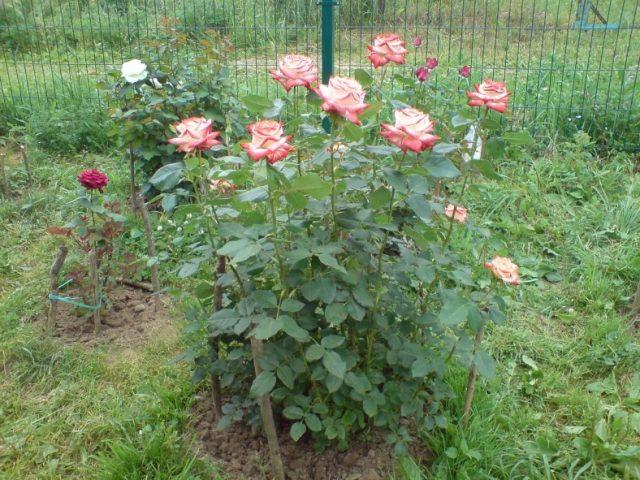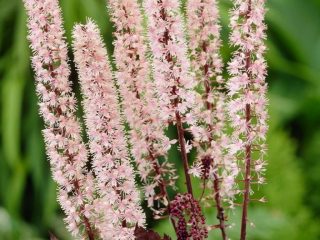Content
Roses have a very wide variety of varieties. Breeders have created flowers with the most unusual and imaginative colors of petals. Among the successful examples is the hybrid tea rose Empress Farah. It is distinguished not only by its original colors, but also by long-lasting flowering and good immunity, so gardeners are ready to “put up with” some peculiarities in care.
History of origin
Empress Farah is a hybrid tea rose from the French nursery Delbard. It was created in the mid-80s of the twentieth century, was registered in catalogs for professional breeders as DELivour, and went on sale under the name Strawberry Parfait. The rose became part of the “Great Colors” series, which united varieties with unusual petal colors.
However, in 1992 the variety was renamed. The Delbar nursery was visited by the first woman in the history of the Persian monarchy - Farah Pahlavi, the third wife of the Iranian Shah Mohammad Reza Pahlavi.
Empress Farah was not a figurehead; she made a great contribution to the development of art and culture in Iran. She also came up with the idea of creating fruit and flower gardens.

In the 70-80s, Farah Pahlavi actively developed relations with the world's leading nurseries, including the rose-growing company Delbar
After the revolution in Iran in 1979, Farah Pahlavi and her husband and children were forced to leave the country, going into exile. For the next few years they lived in Egypt, then began wandering around many European countries.
During a visit to France in 1992, Farah Pahlavi visited the Delbar nursery, whose owner invited her to choose any rose, promising to rename the flower in her honor. The Empress chose the Strawberry Parfait variety.
Description and characteristics of the rose Empress Farah
Rose Empress Farah is a fairly large bush, reaching 1.5-2 m in height and 0.8-1.2 m in diameter. In shape it slightly resembles a broom - the base is strictly vertical, then the crown gradually expands to the sides.

The stems are relatively thin, but strong, withstand gusts of wind and the weight of flowers
The shoots are covered with numerous spines pointing downward at a slight angle. The bush is densely leafy, the leaf blades are quite large, with a glossy tint.

The leaves are lighter in color than most roses and “softer” to the touch.
The flowers of the Queen Farah rose are single, occasionally there are clusters of 3-5 pieces. The buds are tall, classic goblet-shaped. They are considered semi-double, each consisting of 17-25 petals. Despite their relatively small number, the flowers are densely packed. They do not open completely, only the edges of the petals bend slightly back.
The diameter of Empress Farah roses reaches 12-13 cm. The main color of the petals is snow-white or creamy, the reverse is silver-pearl. There is a “blurred” red-pink border along the edge. Its shade depends on the composition of the soil, quality of care, light level and other factors. It can be very bright or close to pastel pink. Occasionally, a lilac, coral or yellowish-orange undertone appears.

As the petals fade, they gradually “fade” and become white
Rose Empress Farah is a re-blooming variety. The first “wave” begins approximately in mid-June, the second - at the end of July or the first days of August. Their duration is 15-20 days. Judging by the photo, description and reviews of gardeners, the Princess Farah rose has a second “wave” of flowering that is more abundant than the first, but at the beginning of summer the flowers are noticeably larger.
The wilting of the bud lasts for 10-12 days. In hot weather the process goes a little faster. The aroma of the Empress Farah rose is very subtle, barely perceptible, and in the evenings its intensity weakens even more.

Empress Farah rose flowers are not damaged by wind and rain
Winter hardiness of rose Empress Farah
According to the official description, in terms of cold resistance, the Empress Farah rose belongs to USDA zone 6. This means that the bush with minimal or no damage overwinters at temperatures down to -18-23.3°C.Accordingly, in southern Russian regions with a subtropical climate, this variety does not need shelter. In the conditions of central Russia, “thermal insulation” will be required. It is not recommended to grow this variety in regions with harsher climates.
Advantages and disadvantages
Initially, the Empress Farah rose was created as a cut rose. Its flowers in a vase remain presentable for up to 7-10 days.

Most gardeners are sure that the Empress Farah rose is almost devoid of aroma
Pros:
- very good immunity against major crop diseases;
- dense foliage of stems;
- powerful shoots that can withstand the weight of the buds;
- long flowering;
- large, densely “stuffed” flowers of exquisite regular shape;
- original, rarely seen color of the petals;
- preserving the decorative effect of flowers in wind and rain.
Minuses:
- insufficient cold resistance for many Russian regions;
- “large size” of the bush;
- not very neat crown shape, which cannot be corrected by pruning;
- stems densely strewn with sharp thorns;
- practically no aroma.
Growing and caring for the Empress Farah rose
Since in Russia the Empress Farah rose is grown mainly in the south, it is most often planted in the fall, about a month before the first frost. The place for the flower bed is chosen taking into account the “requirements” of the variety:
- good lighting;
- availability of protection from cold drafts;
- possibility of normal aeration;
- loose, but at the same time quite fertile soil;
- neutral or slightly acidic pH.

A site in direct sunlight is also suitable for this variety.
The approximate dimensions of the planting hole are 50-60 cm in depth and diameter. A drainage layer is required at the bottom. The soil is “enriched” with humus and complex fertilizer.
Caring for the Empress Farah rose includes the following activities:
- Watering. The variety is not particularly moisture-loving; an adult bush requires weekly watering (15-20 l). In extreme heat, the intervals are reduced to 3-4 days.
- Feeding. In mid-spring, the soil in the flowerbed is watered with a solution of mineral fertilizer. Humus is added annually or once every 2-3 years to restore soil fertility. From the moment the buds form until the end of September, at intervals of 2-2.5 weeks, the bush is fed with a special fertilizer for roses.
- Trimming. Sanitary pruning is carried out every spring and autumn. Also, at the beginning of the season, healthy shoots need to be shortened by about a third. Bushes older than 8-10 years need rejuvenating pruning - every year they get rid of 1-2 of the oldest shoots.
- Shelter for the winter. The tree trunk circle, cleared of debris, is covered with a thick (8-10 cm) layer of mulch. At the base of the bush, a “mound” 20-25 cm high is created from it. The stems are tied, if possible, and wrapped with covering material or burlap in 2-3 layers.

In spring, the winter shelter is removed as soon as the temperature reaches above zero
How does it reproduce
The only way to get new specimens is cuttings. Growing seedlings from seeds is useless - one can almost certainly say that they will not “inherit” the color, size, shape of flowers and other characteristics of the “parent”.
It will not be possible to root the cuttings due to the fact that the stems of the Empress Farah rose are thin but tough. It is almost impossible to bend them to the ground without breaking them.
Planting material - the tip or middle part of a not completely lignified shoot 10-15 cm long with 2-3 leaf buds. Cuttings of the Empress Farah rose are cut at the end of May or in the first half of June.About a third of the existing sheet plates are left.
The lower cut of the cutting is made at an angle. It is soaked for 4-6 hours in a solution of a root formation stimulator or sprinkled with a powdered preparation of a similar effect.
The cuttings are rooted in plain water or in a weak solution of a biostimulant, changing the liquid 1-2 times a day. Any moisture-intensive substrate is also suitable - sand, perlite, vermiculite.
Containers with cuttings are covered, creating a “greenhouse effect”. If you do not let the soil dry out and provide them with 10-12 hours of daylight, roots will appear within 3-4 weeks.

In autumn, new specimens of the Empress Farah rose can be planted in a permanent place
Pest and disease control
Rose Empress Farah is characterized by very high resistance to the most dangerous fungal diseases for the crop - black spot and powdery mildew. It also rarely picks up other pathogens, the only exception being rust.
Its main symptom is patches of “hairy” plaque on the underside of the leaves. As they develop, their bright saffron hue changes to rusty brown, and the coating itself seems to “thicken.” The tissues underneath dry out and die.
To prevent fungal diseases, two treatments with fungicides are sufficient - at the beginning and at the end of the season. A solution of copper-containing preparations is sprayed not only on the bush itself, but also on the soil in the flowerbed.

If rust is “picked up” by other crops in the garden plot, the preventive treatment of the Empress Farah rose is repeated.
Pests do not have any special “love” for this variety.The most common problem gardeners face is aphids. Small insects feeding on the sap of the plant cling to the bush en masse, concentrating mainly on the most “tender” parts - young leaves and buds. Almost any universal insecticide will help get rid of aphids on the Empress Farah rose.

Before treating aphids, it is recommended to cut off parts of the plant where the maximum concentration of insects is observed.
Application in landscape design
In landscape design, the Empress Farah rose variety is used as a bright accent in the flowerbed. The unusual coloring creates certain difficulties with the choice of “companions”.
Empress Farah looks most advantageous against the backdrop of “discreet” pastel colors. Nearby you can plant roses with ivory, cream, snow-white, pale pink petals.

Unsuccessful combination - any other roses with two-tone or more complex petal colors
For “solo” plantings this is not the best option. Despite the dense foliage, the configuration of the bush of the Empress Farah rose is quite “sloppy”, it seems as if “disheveled”, long straight stems “stick out” in different directions.
Conclusion
Rose Empress Farah is a variety with an original two-tone color of the petals. The unusual appearance and other advantages of this variety clearly outweigh its disadvantages. The variety cannot be called extremely “capricious” and demanding to care for, although, of course, it also has its own requirements for the planting site and nuances of agricultural technology. And they need to be studied in advance so that the Empress Farah rose shows its decorative properties to the fullest.
Reviews of the rose Empress Farah








